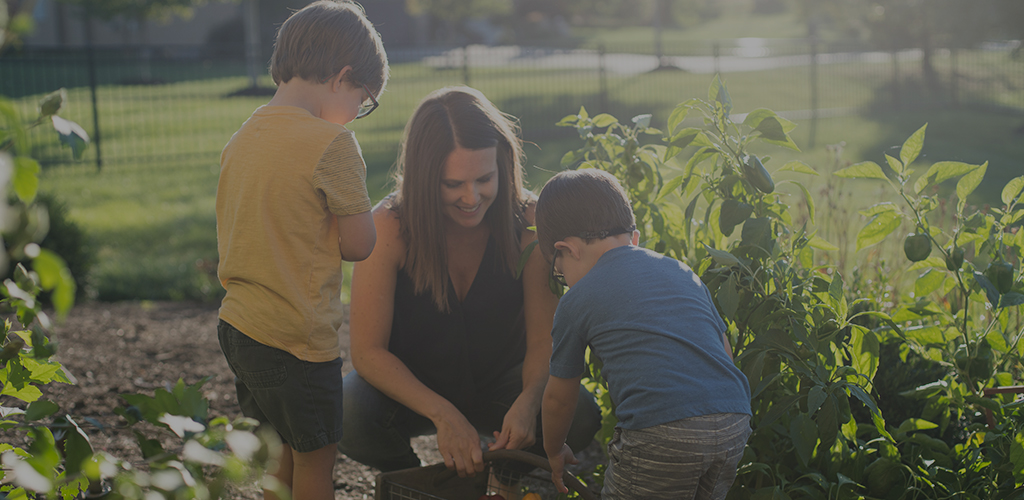I have been learning to garden for the last 8 or so years. I started with a small raised box and have now migrated to a fenced in area with four raised beds, three open in ground areas and a few pots of herbs. I am not great at it, but have learned a few things over the years and continue to experiment and try new things.
It brings me so much joy to see my kids eat stuff off the plant and also when I hear them telling neighbor kids about our arugula plants – something a lot of adults don’t even know about! Learning where food comes from, how it is grown and taking care of it, are valuable lessons for children.
Is starting to grow your own food part of your wellness journey? It’s not too late to get some summer plants in the ground or maybe start thinking about fall plants. Today, I am going to share some things that helped me when I was first starting out.
Two overall lessons learned from my early days:
- Need to pay attention to the time of year to plant things. Most seed packets give you direction.
- Some things are better to start from seed in your home earlier before the planting season or as a starter plant. Doing as a seed in the ground when the appropriate season has arrived will not leave enough time for the produce to grow.
Let me dive in a bit further.
What you plant and when will depend on the area of the country you live in, but for us in the midwest we have a Spring/Fall season that I usually plant in April and September. And then a Summer season that I usually plant around Mother’s Day.
Here is a summary of what we plant and what season:
| Spring / Fall | Summer |
| Swiss Chard | Tomatoes |
| Kale | Zucchini |
| Arugula | Cucumber |
| Leaf Lettuce | Green Beans |
| Radish | Watermelon |
| Snap Peas | Cantelope |
| Kohlrabi | Peppers |
| Cabbage | Okra |
| Broccoli | Mint |
| Cauliflower | Basil |
| Strawberries (spring only) |
Here is what I recommend as far as planting from seed or a plant starter:
Again, if you want to do all seeds because that is definitely cheaper, you will likely need to start the ones in the plant column in your house. I have not done this yet but believe most people start this process a few months before it is ready to go on in the ground.
| Seed | Plant |
| Swiss Chard | Kohlrabi |
| Kale | Cabbage |
| Arugula | Broccoli |
| Leaf Lettuce | Cauliflower |
| Radish | Tomatoes |
| Snap Peas | Peppers |
| Zucchini | Strawberries |
| Cucumber | |
| Green Beans | |
| Watermelon | |
| Cantelope | |
| Okra | |
| Herbs |
Things I haven’t been successful with:
- Cilantro
- Brussel sprouts
Next on my list to try:
- Asparagus
- Onion – regular size and green onions
- Garlic
- Sweet potatoes
- Bokchoy
- Beets
- Blueberries
Few additional tips and tricks:
- Mint and strawberries are best in their own designated box / pot. They will come back year after year and grow / spread.
- I use a row cover over my cruciferous veggies (broccoli, cauliflower, cabbage, kale). These items will get cabbage worms on them. I have not wanted to spray, although even organic versions of this produce at the store have likely been sprayed with an approved pesticide. The other option is to manually remove the worms – no thank you!
- Buy a cheap sprinkler and hook it up to a timer to help you be successful with watering.
- Buy a climbing trellis for your cucumbers and zucchini.
- Consider buying organic seeds and starter plants for the produce on the Dirty Dozen.
Do you have a garden? If so, I would love to hear your favorite things to plant?
**Some of these links may be affiliate links. Embrace Wellness LLC is a participant in various affiliate programs designed to provide a means to earn advertising fees by linking to products they trust and recommend. If you purchase a product through an affiliate link, your cost will be the same and in some cases less, but Embrace Wellness may receive a small commission. Your support is greatly appreciated and helps us maintain this work!

